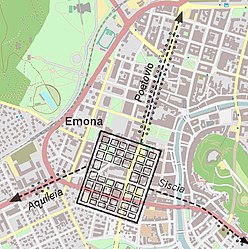Emona
| Colonia Iulia Aemona | |
|---|---|

Location of Emona in modern Ljubljana
|
|
| Alternative name(s) | Emona, Aemona |
| Type | Castrum, Colonia (after 43 AD) |
| Province | Italia |
| Administrative unit | Venetia et Histria |
| Limes | Claustra Alpium Iuliarum |
| Directly connected to | Poetovio • Siscia • Aquileia (via Nauportus) |
| — Stone structure — | |
| Built during the reign of | Second Triumvirate, Gaius Calvisius Sabinus, Lucius Marcius Censorinus |
| Built | 35 BC |
| Size and area | 540 m x 430 m (23.2 ha) |
| Shape | Rectangular |
| — Legions — | |
|
|
| Events | 35 BC - AD 43, Colonia AD 43 - 452 |
| Place name | Ljubljana |
| Town | Ljubljana |
| County | City Municipality of Ljubljana |
| Country | Slovenia |
| Condition | Ruined |
| Exhibitions | City Museum of Ljubljana |
| Website | City Museum of Ljubljana |
Emona or Aemona (short for Colonia Iulia Aemona) was a Roman castrum, settled by colonists from the northern part of Roman Italy. Emona itself was the region's easternmost city, although it was assumed formerly that it was part of the Pannonia or Illyricum, but archaeological findings from 2008 proved otherwise. It was located in the area where the navigable Ljubljanica came closest to Castle Hill. The river played an important role as a transport route for the trade between the city and the rest of Roman empire. From the late 4th to the late 6th century, Emona was the seat of a bishopric that had intensive contacts with the ecclesiastical circle of Milan, reflected in the architecture of the early Christian complex along Erjavec Street in present-day Ljubljana.
The Visigoths camped by Emona in the winter of 408/9, the Huns attacked it during their campaign of 452, the Langobards passed through on their way to Italy in 568, and then came incursions by the Avars and Slavs. The ancient cemetery in Dravlje indicates that the original inhabitants and invaders were able to live peacefully side by side for several decades. After the first half of the 6th century, there was no life left in Emona. The 18th-century Ljubljana Renaissance elite shared the interest in Antiquity with the rest of Europe, founding the Ljubljana creation myth on image of Jason and the Argonauts. In 2014, it is the 2000-year anniversary of the first written mention of Emona. Other ancient Roman towns located in present-day Slovenia include Nauportus (now Vrhnika), Celeia (now Celje), Neviodunum (now the village of Drnovo) and Poetovio (now Ptuj).
During the 1st century BC a Roman military stronghold was built on the site of the present Ljubljana, below Castle hill. Construction of the Roman settlement of Emona, fortified with strong walls, followed in AD 14. It had a population of 5,000 to 6,000 people, mostly merchants and craftsmen, and was also an important Early Christian centre with its own goddess, Equrna. Emona’s administrative territory or ager stretched from Atrans (Trojane) along the Karawanks mountains towards the north, near Višnja Gora to the east, along the Kolpa River in the south, and bordered to the west with the territory of Aquileia at the village of Bevke.
...
Wikipedia

